

![[backarrow]](b_arrow.gif) :tilbake til hovedsida..........jump to the English main page:
:tilbake til hovedsida..........jump to the English main page:
![[english-arrow]](c_arrow.gif)


Here are some pictures from my album:
First of all a winter picture. This is our house in February 2000, a couple of weeks after we got the sun back. This was one of the heaviest snow winters the last fifty years. Showeling snow off the roof was necessary, or else it might cave in. Many roofs did so this winter, but not ours! The children were happy, building snow caverns and sliding down the big heaps heaps. You can see their tracks in this picture. The car owners were not so happy ... |
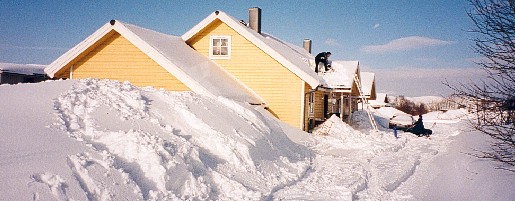 |
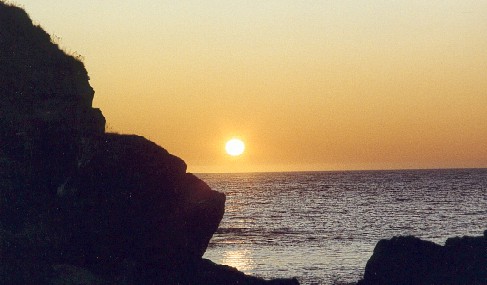 |
North of the Arctic circle (66o 33' N) you can see the midnight sun for some weeks in the summertime. We live at 69o N, and we have midnight sun almost two months every year. Of course, we can't see it when the sky is cloudy ... In the midnight sun season there are no darkness at night. You can sit outdoors and read a book, if you wish. Of course, the opposite season is "mørketida" - the murky time, an equally long period without seeing the sun. We are use to both, summer nights with sunshine and winter days in darkness. Most people point their cameras towards the sun precisely at midnight, but that's an hour too early. Remember the daylight saving time? That's right, all clocks are turned one hour forwards from March to October. |
|
As I mentioned above, the midnight sun may spend it's yellow-red light in vain behind thick grey clouds. Or it can disappear in a fog. Summer and fog banks belong together. After a couple of warm and sunny days the fog will drift in, as it does in this picture. When warm and moisty air meets the far colder ocean (yes, the Gulf stream waters isn't as hot as many believe), then the fog appears from nowhere. Suddenly you're surrounded by grey wool, and hopefully you're on land then. To be at sea in fog can be a frightening experience. You quickly lose every sense of direction and distance. Many have lost their lives, too. This picture shows a place called Høydalen - The Grassy Valley. Around 1680 all the people who lived there, the sources say thirteen, were buried under stones and gravel coming from a steep mountainside to the left. |
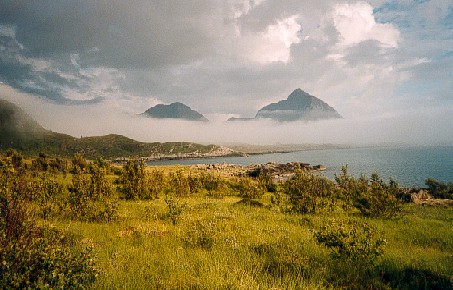 |
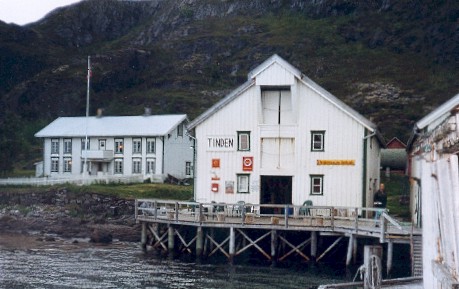 |
In Vesterålen the nature is beautiful and shows great variation. But for me the most interesting things are history and culture. Here we are at Tinden, a very old fishing hamlet beneath a steep mountain (see the black-and-whites). For many hundred years the fishermen have lived here in the winter season and delivered their catches for drying and shipping to Bergen. The house with many windows was built in the 1860s. The owners of this place have lived there until today. Now the harbour is empty during the fishing season, and Tinden is more or less a museum. The Norwegian State has even decided that this place shall be kept as it is today, so people in the future shall be able to see what an old fishing hamlet looked like. |
On the same island where Tinden is situated there is another and newer fishing hamlet called Skipnes. The situation is the same as in Tinden: No fishing boats delivers their catches there any longer. However, the owners have started a new "industri" there - tourism. This picture is taken on an event called "Night in Skipnes". One night in July people gather to talk and dance and of course drink a little in the glare from the midnight sun. No roads leads to Skipnes, so everyone has to use a boat. A thousand visitors is not unusual, as on this night you can look at. |
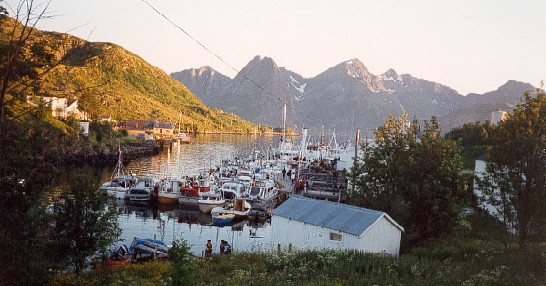 |
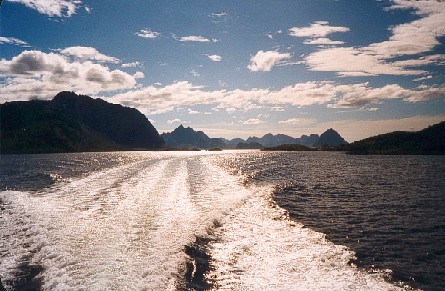 |
We're travelling eastwards, leaving Tindsøya with Skipnes and Tinden behind in the far background. To the right in the picture we have Skogsøya and to the left Langøya, the third largest island in Norway. The sea was the main road for everyone for many thousand years, but now most of the traffic goes on land. The small islands in Øksnes never got connected to the mainland with bridges or ferries, that is one of the reasons for declining populations there. I am on board the speed shuttle that carries people, mail and goods between the islands. A trip with this boat on a fine summer day is a manificent experience. In the winter it can be quite another story! |
On Skogsøya stands an old timber church. Some of the timber logs are at least five hundred years old, but the church itself has been much changed during the centuries. Most of all it has been increased in size to give room for a growing population. Now this magnificent old church is empty almost every Sunday. Skogsøya is no longer the administrative centre in Øksnes, and a new church has been built on the mainland, where most of the people live now. However, one Sunday each summer people gather her to remember all the fishermen who disappeared at sea. In front of the church, near the shore, you can see a white monument. There a wreath is placed to honor all those who never came back. There are no names at this memorial. The list of all dead at sea would be far too long. |
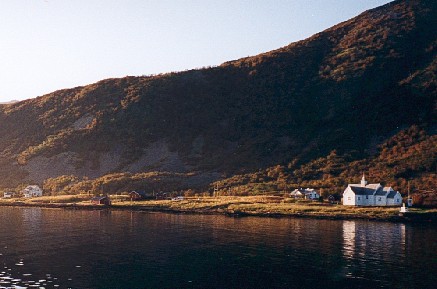 |
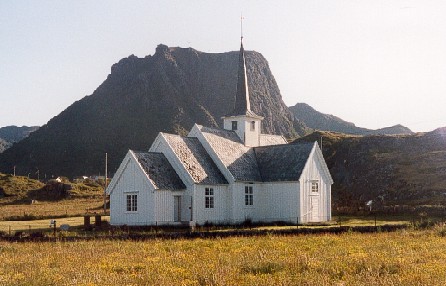 |
The church in Øksnes has a "sister" in the neighbouring parish Langenes, equally old and interesting. This church stands near the northern point of Langøya, at a place called Langenesværet, where scientists are digging their way down the centuries only a few meters away. Four hundred years or and more there was a little town there, of course populated mostly by fishermen and their families. There are very good fishing banks at a short distance from the shore, and the harbour was well suited for the needs in older times. You won't see any fishing wessels in Langenesværet today, the harbour is too shallow for them now. I turned my back to the church and took the next picture, so look for yourself! In the background you can see another large island in Vesterålen, Andøya. |
